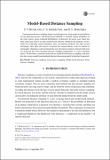Model-based distance sampling
Abstract
Conventional distance sampling adopts a mixed approach, using model-based methods for the detection process, and design-based methods to estimate animal abundance in the study region, given estimated probabilities of detection. In recent years, there has been increasing interest in fully model-based methods. Model-based methods are less robust for estimating animal abundance than conventional methods, but offer several advantages: they allow the analyst to explore how animal density varies by habitat or topography; abundance can be estimated for any sub-region of interest; they provide tools for analysing data from designed distance sampling experiments, to assess treatment effects. We develop a common framework for model-based distance sampling, and show how the various model-based methods that have been proposed fit within this framework.
Citation
Buckland , S T , Oedekoven , C S & Borchers , D L 2016 , ' Model-based distance sampling ' , Journal of Agricultural, Biological and Environmental Statistics , vol. 21 , no. 1 , pp. 58-75 . https://doi.org/10.1007/s13253-015-0220-7
Publication
Journal of Agricultural, Biological and Environmental Statistics
Status
Peer reviewed
ISSN
1085-7117Type
Journal article
Description
CSO was part-funded by EPSRC/NERC Grant EP/1000917/1.Collections
Items in the St Andrews Research Repository are protected by copyright, with all rights reserved, unless otherwise indicated.

